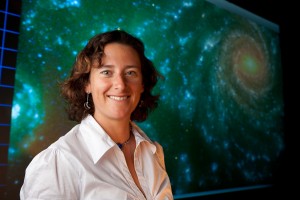Tamara Davis
University of Queensland / University of Copenhagen
In 1998 astronomers made an astonishing discovery-the expansion of the Universe is not happening at a steady rate, nor is it slowing down toward eventual collapse. Instead, it is accelerating. The discovery required a complete rethink of the standard model used to explain how the Universe works.
“Now we know that stars, planets, galaxies and all that we can see make up just four per cent of the Universe,” says Tamara Davis, a University of Queensland astrophysicist.
“About 23 per cent is dark matter. The balance is thought to be dark energy, which we know very little about.”
Tamara is on the hunt for this dark energy. By using the Australian National University’s new telescope SkyMapper to measure the movement of supernovae, she hopes to gain a better understanding of dark energy.
“Supernovae are extremely bright stellar explosions. Because we know how bright they are we can use them as ’standard candles’ to accurately measure distance and motion across the Universe,” Tamara says. “By measuring how fast supernovae are moving, and comparing that to what we expect based on current theories, we may be able to trace the dark matter and energy as well as the visible matter.”
And the SkyMapper telescope offers some unique opportunities for mapping the Universe.
“SkyMapper takes images that are 25 times larger than the full moon. This lets it scan the southern sky once every four days,” she says. “Only a few years ago it took the best telescopes a year to cover the same area. This allows us to look at a much bigger region of the nearby Universe, rather than zeroing in on single objects or distant galaxies.”
Using the SkyMapper data generated over the next couple of years, Tamara hopes to detect invisible dark matter by observing the effects of its gravity.
“We can use the motion of supernovae (not just their position) to measure the 3D distribution of all matter in the Universe, not just galaxies,” she explains. “This will allow us to measure previously unexplored properties of dark matter and dark energy.”
But a complicated study like this requires a lot of scientists with expertise in various areas from observational analysis to theoretical physics. Tamara plans to use her $20,000 L’Oréal Australia For Women in Science Fellowship to pull together an international team of scientists to work on this project.
And she has the runs on the board to do this. She’s already collaborated with many of the leaders in the field including Nobel Laureate George Smoot and Shaw and Gruber prize winners Brian Schmidt, Adam Riess and Saul Perlmutter.
“I’ve been privileged enough to be a member of a number of fantastic teams in my career to date. The Fellowship gives me the chance to establish my own all-star team,” Tamara says.
Background
Qualifications
2004 – PhD (Astrophysics), University of New South Wales
(winner of best Science PhD from UNSW that year)
1999 – Bachelor of Science, First Class Honours (Physics and Astronomy), University of New South Wales
1999 – Bachelor of Arts (Philosophy), University of New South Wales
Career highlights, awards, fellowships and grants
2008- – Research Fellow, School of Mathematics and Physics,
University of Queensland
2008- – Associate Professor, Dark Cosmology Centre
Niels Bohr Institute, University of Copenhagen, Denmark
2006-2007 – Postdoctoral Fellow, Dark Cosmology Centre,
Niels Bohr Institute, University of Copenhagen, Denmark
2005-2009 – SuperNova Acceleration Probe team to develop a new space telescope for US Department of Energy/NASA
2004-2005 – Postdoctoral Fellow, Research School of Astronomy and Astrophysics, Australian National University
Research highlights
- 24 journal articles and reviews, including six as first author, and two book chapters that in total have over 1,000 citations
- Frequent visits to international laboratories to collaborate and learn new techniques (incl. Harvard, Yale, Berkeley, NASA Goddard Spaceflight Ctr, U. Chicago, Princeton, U. British Columbia, U. Copenhagen, U. Oslo, Imperial College London, Cambridge)
- Participated in the ESSENCE supernova survey which discovered over two hundred supernovae and used these to measure the changing expansion rate of the Universe. Used this data to rule out two of the leading alternative cosmological models based on quantum theories of gravity
- Jointly made the first unambiguous detection of time dilation due to the expanding Universe. This was cited amongst the journal Nature’s research highlights for August 2008
- With the Australian team WiggleZ’ making the largest ever three-dimensional map of the distribution of galaxies in the Universe, in order to test new cosmological theories that explain dark energy
Alternative images


video: Jerome Pelletier, www.steppingstone.com.au

